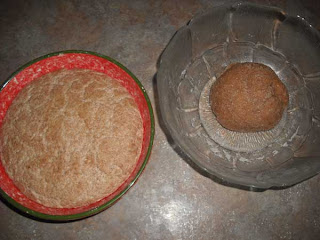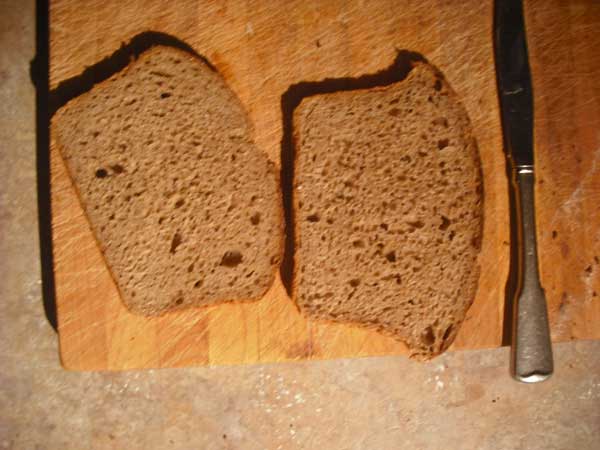
Every fumbling adolescent thinks they have invented sex, and every home baker thinks they have perfected bread recipes. Professional bakers, and those who have been screwing around for years, think they know better.
But everybody only has part of the truth.
Mistakes lead to innovation
The fact is, many new bread making techniques are still being discovered by mistake (although it continues to be the prepared mind that notices, I'll give that to Pasteur). It is conjectured that the first time brayed wheat was ever mixed with water, the unusual properties of gluten were discovered, when what was desired was just another grain porridge. It is also believed that the first time this mixture was fermented with wild yeast, it was yet another serendipitous mistake.
The Romans were called porridge-eaters before they brought back bread-making technologies from their conquered territories and spread it through their empire. And over the centuries since, we've explained some of the mysteries of bread. We've learned some chemistry, we now have models that explain the difference between starches and proteins. We've learned some biology, and we have models that tell us about bacteria and yeast, and more recently have even probed the DNA of our grain. Yes, we've learned how to do some things well, but it can also be said that we as a race of beings living in concert with grains have forgotten a lot of stuff too. I suspect that there is nothing new under the sun regarding bread, but so much still waits to be rediscovered. And we can discover these things by experimentation, and by observing serendipitous mistakes.
And who better than a home baker to experiment with these things? Like an adolescent touching his first female breast, the home baker has a yearning, aching need, and will see the mysteries in ways that experienced and jaded production-line bakers and gigolos have lost forever.
What goes wrong matters
Here are a couple of other more recent (within a generation or three) historical examples of things that went wrong, but that turned out very right.
• Doris Allen discovered no-knead bread when she over-hydrated some dough and it turned out great
• Chad Robertson discovered that retarding the dough overnight in the fridge improved the flavour of his bread
I personally believe that there were also some things that went right, but have turned out very wrong: and of course, I'm thinking of how we've learned how to isolate yeast to rise bread, but this has lead us to forgetting wild yeast cultures, the health benefits of which are clear, and the loss of which has lead to detrimental effects to our health; and another example might be how we have learned to sift the bran from the wheat, leading to loaves that are white and fluffy, when again the health properties of the bran and germ in whole grains is now well known, and frankly ought to be insisted upon.
The very curious thing to me is how a tiny change in method or ingredients can have such profound effects. Something very small can make a drastic difference. But that is bread in a nutshell.
As Bill Buford put it (while learning how to make bread with cool artisan baker Bob at the Phillippe Richard Artisan Boulanger in the short video "Making Bread in Lyon):
Is wheat the most poetic ingredient on the earth?
Grind up any other grain, add water, you get porridge.
Grind up wheat, add water -- metamorphosis.
It becomes stretchy. Push it. Pull it.
It's sticky. Glutens are forming.
The Chinese call it the "muscle" of flour:
its actually one long, elastic molecule, probably the longest on the planet.
Knead it again, and it grows longer still.
But its temperamental.
It stops if everything is not
just
so.
My Sandwich Loaf Revisited
Here is an example of a mistake I made. In this case, it did not lead to an innovative technique, but confirmed for me that my recent recipe (itself a result of experimenting with mistakes) was on the right track. Let's recap the recipe in a nutshell so you don't have to flip to my originating page:
My WW Wild Yeast Sandwich Loaf Recipe (using a stiff starter)
• 200g sourdough starter @100% hydration (i.e. 100g wheat, 100g water)
• 100g whole wheat flour
Mix to a stiff dough starter and leave covered overnight.
• 700g whole wheat flour
• 700g water
• 18g salt
Mix stiff starter and water, then pour into flour and mix thoroughly. After 30 minutes, sprinkle salt on. Fold every 30 minutes for 3-4 hours until the dough feels effervescent. Form into a tight ball and squeeze it into a buttered tin. Allow to proof another 2-4 hours, paint the top with kefir and bake with steam at 450 degrees F, for 20 minutes then remove the steam pan, turn the tin and bake another 20-30 minutes.
I refreshed my sourdough the other day, and instead of tossing out the discard, I divided it and used it to bake two loaves of bread using this, my recent sandwich loaf recipe. But in one dish, I used 200g of old starter with 100g of new flour to make the stiff starter that I described in the recipe; in the other, I accidentally dumped 200g of new flour into the old starter. "No problem," I thought, "I'll just add 100g of water to that mixture, and subtract that fluid from tomorrow's hydration."
To recap the mistake: the loaf on the left was built this way:
• 200g sourdough starter @100% hydration (i.e. 100g wheat, 100g water)
• 200g whole wheat flour
• 100g water
• 600g whole wheat flour
• 600g water
• 18g salt
This experiment would thus answer the questions: why is a stiff starter necessary for my recipe? Can't it be built with a softer starter?
That was the only difference between the loaves.
The loaf on the left had the soft starter, the loaf on the right had the stiff starter.
From the very start of mixing these loaves, they felt quite different --
-- and although both loaves did achieve some silken stretchiness, they always felt different while stretching and folding them in the bowl.
The one with the soft starter felt sloppier, became effervescent faster, rose quicker (and in fact, overflowed the tin before it hit the oven).
The one with the stiff starter was more difficult to mix, slower to get started, but always more manageable as a dough.
It was easier to shape, and had a much more dramatic but controlled oven spring.
The interior crumb looks pretty much the same in both loaves. But there is a dramatic difference in taste. The loaf with the soft starter is more sour.
Crumb Shots
Here the loaves are on opposite sides. The mistake-loaf is on the right now.
Bread: will it every be as good as sex?
Notes to Myself
- A stiff starter is a good idea. A sloppier starter seems to give you a quicker rise, but is harder to control the dough and the taste.
- I would really love to be able to see the yeast and bacteria of my sourdough culture, and to measure the many properties of the mixture. I have this desire to learn more about what it is that I'm actually doing. I wish I had a decent microscope and could examine some of the fine details of the beasts with whom I live in concert.
- My wife thinks that these loaves are not baked properly, and they are indeed so moist, you might think the same thing. I find that the extra moisture is preferred by people who otherwise don't like my bread because they feel it is too hard. For those like my father who likes his white bread (that doughy, soft, tasteless stuff that gets extruded out of the wonder-machines), this bread is something that he will eat, while he often turns up his nose when I offer him the artisan style loaves I mostly bake.
- This loaf isn't everyone's preference, but I offer it as something else to try for those who generally despise harder bread.
- I will eat these lightly toasted, and they remain soft.




















No comments:
Post a Comment